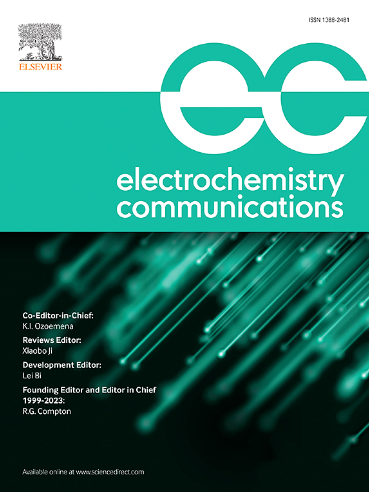Copper (II) anchored on guanidine-functionalized graphene oxide as a high-performance supercapacitor electrode: An experimental and theoretical investigation
IF 4.7
3区 工程技术
Q2 ELECTROCHEMISTRY
引用次数: 0
Abstract
This study investigates a low-cost and effective supercapacitor (SC) electrode material that represents an important step toward sustainable development. For this purpose, copper (II) anchored on guanidine-functionalized graphene oxide (GGO/Cu) was synthesized via a facile two-step route. Various analytical techniques, such as Fourier transform infrared spectroscopy (FT-IR), X-ray diffraction (XRD), Raman spectroscopy, scanning electron microscopy (SEM), transmission electron microscopy (TEM), and elemental mapping, were utilized for phase and morphology investigation of the GGO/Cu. The electrochemical performance was assessed through cyclic voltammetry (CV), electrochemical impedance spectroscopy (EIS), and galvanostatic charge/discharge (GCD) in the 6 M KOH electrolyte. The GGO/Cu electrode demonstrated a high specific capacitance of 1224 F g−1 in the potential window of 0 to 0.45 V at the current density of 2 A g−1. The as-prepared electrode exhibited excellent cyclic stability and good capacitance retention of 68 % after 5500 cycles at the high current density of 20 A g−1. Furthermore, for theoretical studies of GGO/Cu electrode, density functional theory (DFT) calculations were employed and the results suggested the improvement of the quantum capacitance (CQ) and confirmed the experimental findings.

锚定在胍功能化氧化石墨烯上的铜(II)作为高性能超级电容器电极:实验和理论研究
本研究研究了一种低成本、高效的超级电容器(SC)电极材料,这是迈向可持续发展的重要一步。为此,通过两步法合成了锚定在胍功能化氧化石墨烯(GGO/Cu)上的铜(II)。利用傅里叶变换红外光谱(FT-IR)、x射线衍射(XRD)、拉曼光谱(Raman spectroscopy)、扫描电子显微镜(SEM)、透射电子显微镜(TEM)和元素映射等分析技术对GGO/Cu的物相和形貌进行了研究。通过循环伏安法(CV)、电化学阻抗谱法(EIS)和恒流充放电(GCD)对6 M KOH电解质的电化学性能进行了评价。在电流密度为2 a g−1时,GGO/Cu电极在0 ~ 0.45 V的电位窗口内具有1224 F g−1的高比电容。在20 A g−1的高电流密度下,经过5500次循环后,所制备的电极具有优异的循环稳定性和68%的良好电容保持率。此外,采用密度泛函理论(DFT)对GGO/Cu电极进行了理论研究,结果表明GGO/Cu电极的量子电容(CQ)得到了改善,并证实了实验结果。
本文章由计算机程序翻译,如有差异,请以英文原文为准。
求助全文
约1分钟内获得全文
求助全文
来源期刊

Electrochemistry Communications
工程技术-电化学
CiteScore
8.50
自引率
3.70%
发文量
160
审稿时长
1.2 months
期刊介绍:
Electrochemistry Communications is an open access journal providing fast dissemination of short communications, full communications and mini reviews covering the whole field of electrochemistry which merit urgent publication. Short communications are limited to a maximum of 20,000 characters (including spaces) while full communications and mini reviews are limited to 25,000 characters (including spaces). Supplementary information is permitted for full communications and mini reviews but not for short communications. We aim to be the fastest journal in electrochemistry for these types of papers.
 求助内容:
求助内容: 应助结果提醒方式:
应助结果提醒方式:


